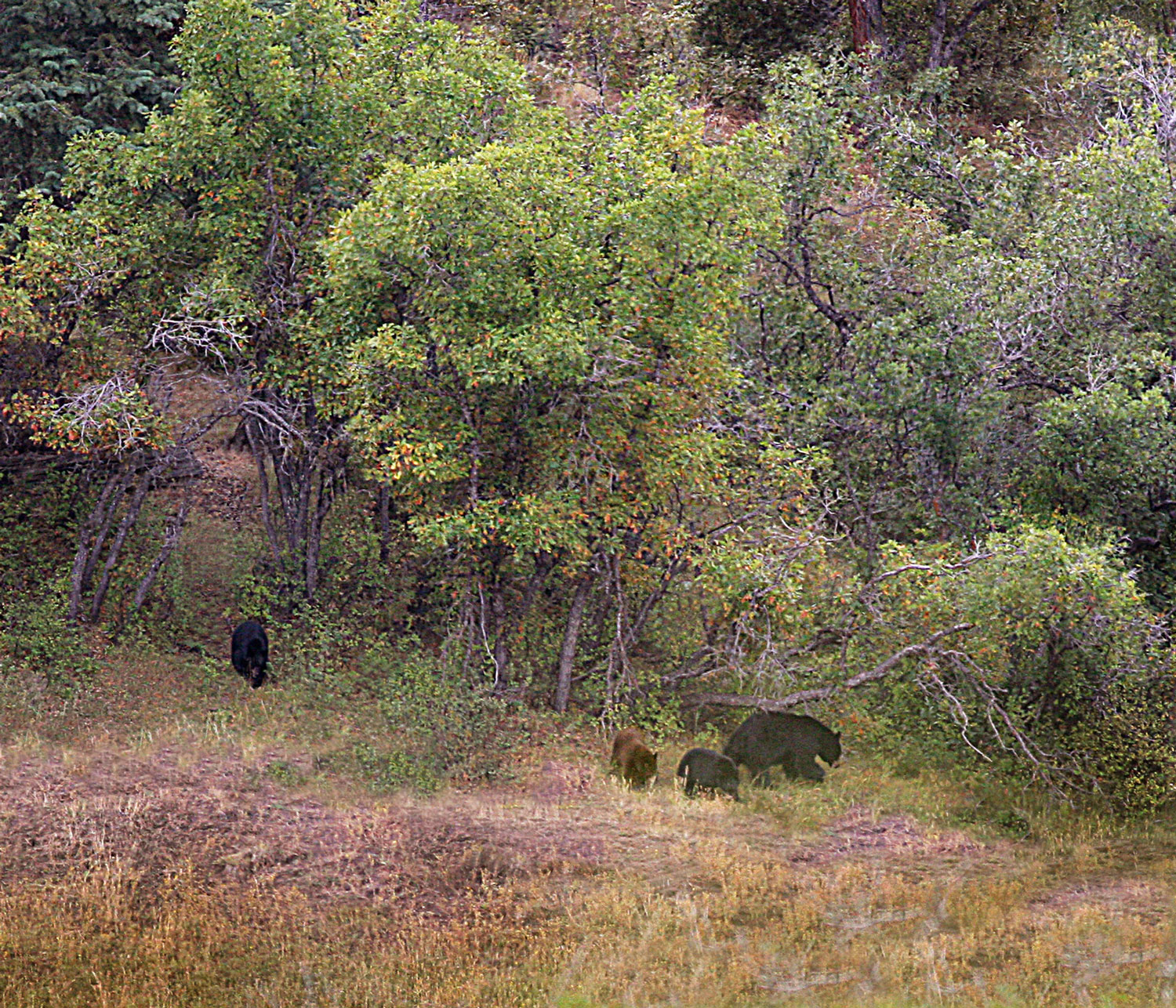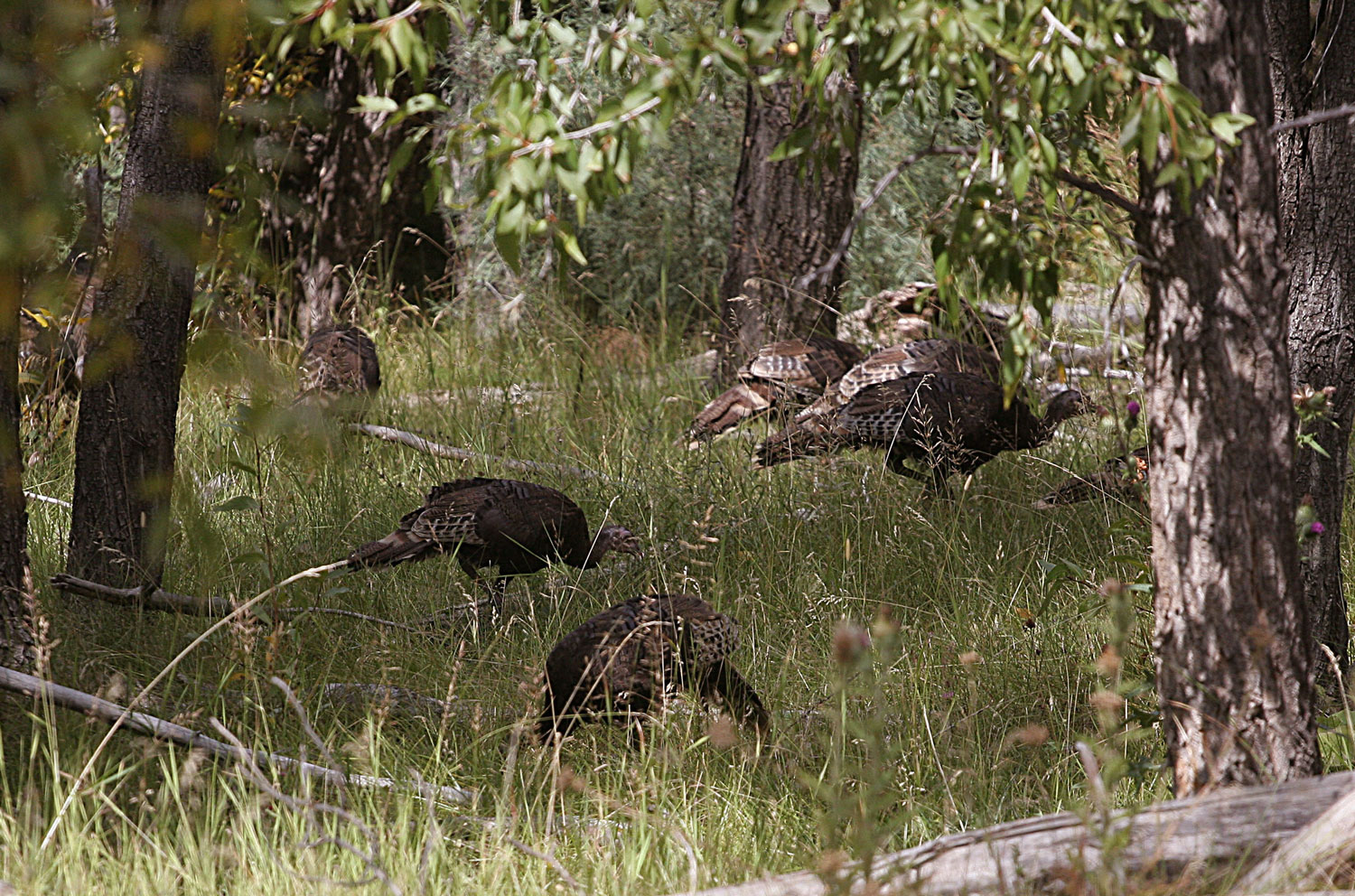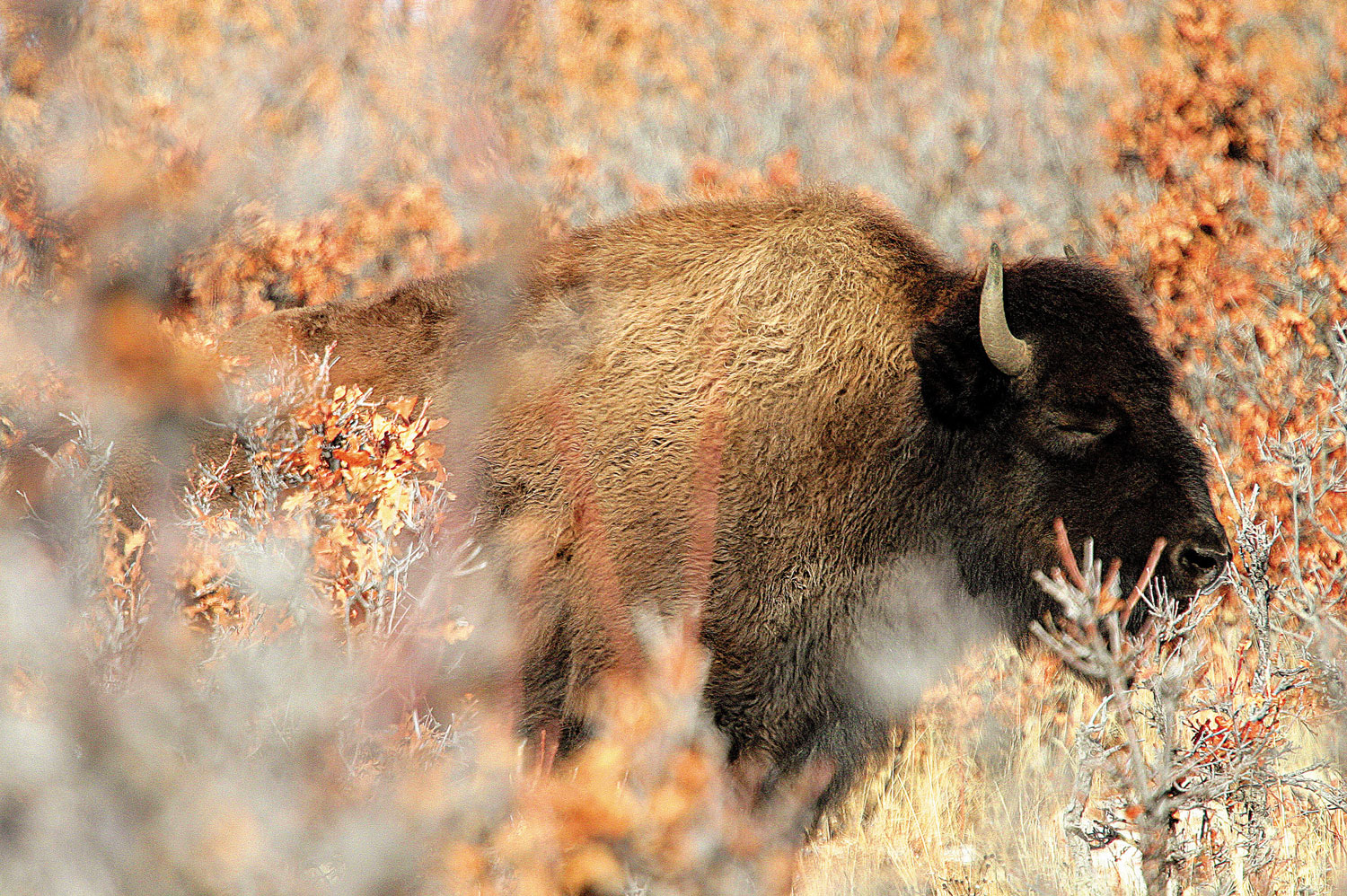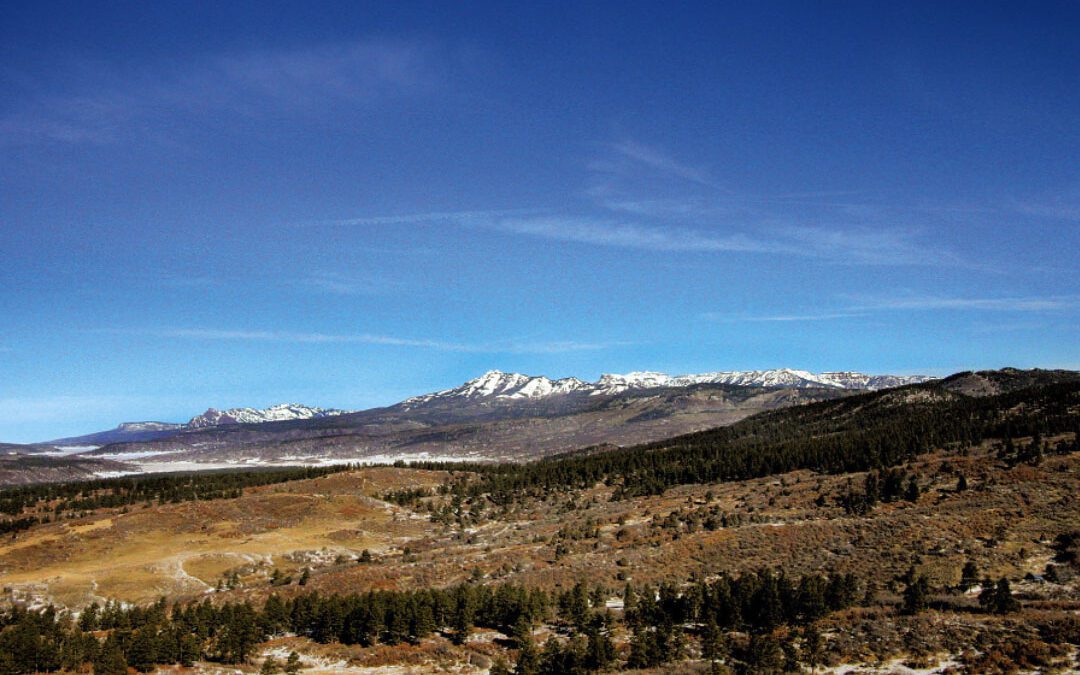We knew they were there. We’d first seen them a year ago this past September—a mama bear and her three cubs working the upper end of, appropriately enough, Bear Canyon.
She was in superb shape, a real veteran and obviously a master at her craft, for each of her cubs was in prime condition as they worked the upper edges of the steep meadow a few hundred yards below us.
They were feeding on what had been a prolific crop of acorns that year in the oak brush that covers the soaring slopes above northern New Mexico’s legendary Chama Valley. And though we were there scouting for mule deer, we were enthralled watching this magnificent grouping of bears below us.
Two of the cubs were coal black, but the other was a rich mahogany brown and unquestionably the dominant member of the three, both in size and attitude. But as rambunctious as the cubs appeared to be with one another, it was clear that they had been very well schooled, for they followed their mother’s every directive without question as they fed along the lower canyon wall.
The following spring they were spotted again when a guide and his hunter surprised them while scouting the high northern rim of the canyon for Merriam’s turkeys. The big mahogany cub had actually bluff charged them while his lesser siblings had turned and fled, and his mother had charged up the slope with him as he’d bounded to a stop, halting beside him and glaring menacingly at the two hunters as she loudly popped her jaws before ushering her precocious young protégée back into the dark timber.

The entry into the lower reaches of Bear Canyon is deceptively dark and foreboding.
Come September, the foursome was spotted once more by an elk guide, this time farther down the mountain. They were a good thousand yards below him, and he watched them through his spotting scope for several minutes. But even at that distance, the big mahogany cub was significantly larger than his siblings. A month later, a guide and two hunters were challenged by what one of the hunters described simply as “a big brown bear” while they were field dressing an elk deep in the lower reaches of the canyon, and so we were all on alert.
Twice more that season they were spotted at a distance and come spring, the big brown cub was nearly the size of his mother.
There are certain areas in these mountains so rough and rugged that many hunters tend to avoid them altogether, and parts of Bear Canyon and the precipitous slopes that surround it are top of the list.
The place holds game—elk and mule deer and turkeys and blue grouse, and even a few bison that occasionally take refuge there. But it is the Merriam’s turkeys that draw us into the depths of this otherworldly canyon and high along its towering rims each spring.

A springtime flock of Merriam’s turkeys high on the northern rim of Bear Canyon.
For three days we’d been hunting turkeys there, Ben Garrett and me, and for three days we’d been shut out. But on the third evening we found a flock high on the heavily wooded northern rim. The following morning, before first light, we made our move, sporadically crow-calling in an attempt to elicit some sort of territorial response from one of the big gobblers who make their home there.
We approached from below and, once in position, Ben started working down the rim to the west while I continued climbing east into the sunrise.
The morning was a keeper, the air crisp and still, and the view north out across the Chama Valley and up into the snow-capped peaks of southern Colorado was spectacular. Turkeys or no turkeys, the setting alone and the acute silence that engulfed everything around us had all been worth the effort it took to be there.
And then the silence was disturbed.
Initially it was only a faint rustle 70 yards or so up the slope above me, so subtle that it nearly didn’t register. But then it came again, and glancing uphill to a long narrow ledge that bordered the thicker timber, I saw it—a dark, furry, mahogany hump, backlit by the rising sun and hovering there just behind the crest of the ledge. My mind flew back to that mama bear and the big mahogany cub who had challenged our friends and their downed elk this past fall, then forward again to how exposed I was, with no place to retreat except straight down the near-vertical canyon walls behind me.
Looking back up the mountain, that big brown hump was still there—for the moment unmoving, but ominous in its presence. Then, to my utter dismay, it was joined by another even larger and darker hump, and suddenly this old double barrel bird gun I was carrying and the No. 6 copper-plated birdshot it held felt pretty darn small.
And, frankly, so did I.
But I had dealt with bears before and knew that if there was a charge, I must stand my ground and not attempt to flee, for fleeing triggers a bear’s instinct to chase and catch and kill.
For a moment, I questioned if perhaps my eyes might be playing tricks on me. But no, those two humps were now slowly and almost imperceptibly shifting to the left, and I couldn’t help but wonder about the two remaining black cubs who had been seen with them. And as I wondered, a third hump appeared, this one four feet to the right of the first two and even darker.
But instead of being black, it too was a deep brown—and suddenly there was another and another, and another still, until there was a whole chorus line of those big shadowy shapes, all of them markedly haloed by the rising sun and extending side to side for 50 or 60 yards, gradually growing from just over the crest of that long rock shelf above me and now beginning to advance up and over the top.
And suddenly everything came clear—
Buffalo.
There must have been at least two dozen of them, probably more, and all my questions had been answered—except perhaps, “What now?”
As I said earlier, we knew there were bison in these mountains. I had seen them before, sometimes in ones and twos and sometimes in whole herds— both at a distance and much closer. But I had never seen them this high.
Their eyesight is rather poor, and they are somewhat color-blind. On occasion, I had hunted them with my cameras, taking great care to remain silent and keep the wind in my face, because both their sense of smell and their hearing are extremely keen. And though they might appear to be ponderous and slow, they can be fast and nimble when the situation requires it.
And for me, this was rapidly becoming a sure enough, eye-to-eye situation.
For they now had position on me, and my options were becoming ever more limited. But dressed in proper camo as I was and standing deep in shadow, I felt fairly certain they still didn’t have a firm visual fix on my location.
But they had clearly heard our earlier crow-calls, and their piqued curiosity had drawn them down the mountain toward us. And with the breeze in my face, I was beginning to get a few subtle whiffs of them as they advanced.
They are shy creatures, these high-country bison. But when threatened they can be fierce. Still, my read on them was that they were feeling more curious than threatened, and for the time being they seemed more inquisitive than hostile.
They undoubtedly knew I was there. Seventy yards had become 60, and 60 yards soon became 50 before they paused. There were both cows and bulls and, more significantly, several small calves whose rustic orange coats stood out like targets for any potential predators. And when the safety of bison calves is involved, there can be no room for error.
And so I stood, still and unflinching there in the deep shadows that surrounded me. To my left, the slope angled directly down the mountainside, and to my right it rose to the sky.
A couple of yards behind, the canyon itself plummeted into near darkness, and a few feet in front between the bison and me the ground was bathed in a long swath of new morning sunlight with the still-milling herd now scarcely 50 yards above me.
Then slowly and with great curiosity, they began moving once more, spreading out until they were more or less even with me to the left with my entire right flank blocked by the canyon rim itself. And now I knew that my only escape route, if required, would be straight down into the deep dark depths at my back.

The author hung with this lone big bull for the better part of the morning before working into position for this one photograph of him napping.
It was a curiously interesting, even exhilarating, circumstance, and I felt an invigorating sense of awe and elation sharing the company of such grand and glorious creatures as these and reading their eyes and movements as they tried to figure me out.
I knew full well that their primary concern would be the welfare of their little ones, and that the longer it took them to decide whether or not I posed a threat, the more likely it would become that they might feel the need for aggression.
Their instinctive division of labor would probably dictate that the bulls would be the ones to charge, while the cows ushered the calves to safety; or might one of the mothers be the one to express her innate maternal instincts and initiate the proceedings?
Whatever the scenario, time was decidedly running out and I felt it might be best to make the first move myself rather than leave it to them. And so I lowered my shoulders and arms and gun to my sides to lessen my threat profile, and casually—oh, so casually—eased forward into the sunlight, fully exposed.
Heads turned, ears twitched, noses flared and hooves shuffled wildly, and I could hear the low gravely vocalizations between the mothers and their calves as the whole herd came to full attention with all their senses focused on me.
They had seen my kind before—of that I was certain. But why I was there and whether or not I posed a mortal threat must surely have been a subject of communal consternation, if not outright fear.
I spoke to them in as calm and unthreatening a voice as I could muster, and for a moment we all stood frozen in time.
But only for a moment.
For whatever their apprehensions may have been, they still didn’t fully understand what was happening except to sense that this could well be a dangerous place. And they abruptly turned en masse and thundered back up the mountain with dust and leaves and bits of soil and stone swirling upward and outward in all directions as they vanished like spirits into the dark timber from which they’d first appeared.
The ground shook.
But then, why would it have not?
For there were a dozen or more tons of mass and mayhem and pounding hooves tearing away up that mountainside, more than enough, I knew, to have reduced me to little more than a smear had they so desired.
But they had not.
Instead, they’d chosen to circumvent whatever danger they might have perceived, either real or imagined.
And once more, they were safe.
As was I.
Copies of Michael Altizer’s books, Ramblings—Tales From Three Hemispheres, Nineteen Years to Sunrise, and The Last Best Day, can be ordered online at SportingClassicsStore.com.
The author welcomes and appreciates your comments, questions, critiques and input. Keep in touch at Mike@AltizerJournal.com.

